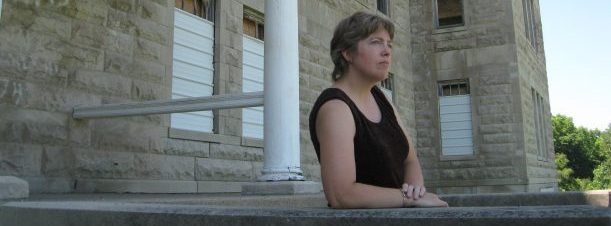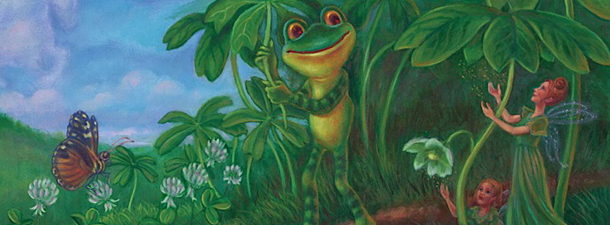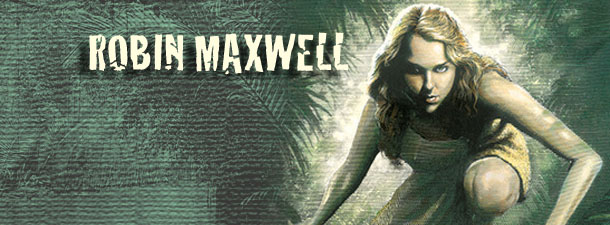Ghosts and books: Interview with Author Sylvia Shults

Sylvia Shults is an author, librarian, ghost-hunter, and historian who wrote the incredible book “44 Years in Darkness” which chronicles the true story of Rhoda Derry, a mentally ill (or bewitched) woman who was confined in a cage at a county poorhouse throughout the late 1800s into the early 1900s. Believed herself to be hexed, Rhoda lost her mind and subsequently wasted away in institutions before being rescued by a kind-hearted doctor and inadvertently became a fixture in the fight for the rights of the insane. Sylvia Shults painstakingly researched Rhoda’s entire sad and strange life story and created a book that captivating on many levels.
Sylvia Shults has spent the past twenty years working in a library, slowly smuggling words out in her pockets day by day to build a book of her own. She sits in dark, spooky, haunted places so you don’t have to. She lives a short, ten-minute motorcycle ride away from the haunted asylum that features in so many of her books. She considers it the highest privilege to share the incredible, compassionate history of the Peoria State Hospital. After battling an intense, lifelong fear of the dark, Sylvia decided to become a ghost hunter. As a paranormal investigator, she has made many media appearances, including a tiny part in the Ghost Hunters episode “Prescription for Fear” which is about the Peoria State Hospital.
Sylvia loves hearing from her readers, especially when they have spooky stories of their own to share with her. She can be found at www.sylviashults.wordpress.com and on Facebook at the pages for Fractured Spirits and Ghosts of the Illinois River.
Sylvia recently granted an exclusive interview where she discussed this book, her experiences as a ghost hunter, and more.
Meagan Meehan (MM) of Entertainment Vine: What prompted you to start writing and which genres most call to you?
 Sylvia Shults (SS): I’ve been an avid reader all my life. My father tells me I taught myself how to read when I was two, so I’ve been at it a while! It was only a matter of time before I realized that hey, maybe I could write, too. I utterly adore horror fiction, so that’s what I started out writing. You can actually find fiction books of mine still floating around out there! Several years ago, I was contacted by a publisher who wanted me to write a collection of true ghost stories. Now, I have always been obsessed with the mysterious and strange, so this project was a childhood dream come true for me. I had so much fun with it, that I decided to switch my focus from fiction to nonfiction. Now I get to immerse myself in true ghost stories and haunted places to my heart’s content and call it research!
Sylvia Shults (SS): I’ve been an avid reader all my life. My father tells me I taught myself how to read when I was two, so I’ve been at it a while! It was only a matter of time before I realized that hey, maybe I could write, too. I utterly adore horror fiction, so that’s what I started out writing. You can actually find fiction books of mine still floating around out there! Several years ago, I was contacted by a publisher who wanted me to write a collection of true ghost stories. Now, I have always been obsessed with the mysterious and strange, so this project was a childhood dream come true for me. I had so much fun with it, that I decided to switch my focus from fiction to nonfiction. Now I get to immerse myself in true ghost stories and haunted places to my heart’s content and call it research!
MM: You work as a librarian, so how much does that help you as both a writer and historian?
SS: Working as a librarian as well as a writer is such a blessing! For one thing, I spend my days surrounded by books, and they actually PAY me to be there! Most libraries have a fabulous service called Interlibrary Loan, which means that if your library doesn’t have a particular book, they can get it from a different library — even out of state. I’ve gotten materials from libraries in Alaska. So, I can get virtually anything that I hear of that catches my fancy. There’s another huge perk that comes with being a librarian who is also known locally as a writer. There are so many of our patrons who come into the library and ask me what I’m working on next. This not only keeps me on track and focused on the next project, it lets me know that people are actually interested in what I write and want me to write more. Not only does it keep me accountable, it’s also a wonderful confidence booster!
MM: How did you hear about Rhoda Derry and why did you select her to focus a book on?
SS: It’s a roundabout story! When I started writing my first book of true ghost stories, “Ghosts of the Illinois River,” I discovered that there was, in fact, a haunted mental asylum just a short ten-minute drive from my own front door. Now, when someone says “haunted mental asylum”, you automatically assume it was a place of pain and fear and abuse. It is my great joy and my privilege to tell people that this was NOT the case at the Peoria State Hospital. This was a place of compassion, not only for the mentally ill, but for the low-income population of the area. But it was the compassion for the mentally ill that really drew me to the place.
The more I discovered about the history of the asylum, the more I grew to appreciate the dedication of Dr. George Zeller and his staff. Dr. Zeller put a standard of care in place that outlived him. For most of its history, the PSH was the epitome of care for those who suffered from the various personal demons that can attack the mind.
When I heard of Rhoda Derry, and learned of her excruciating history, and her eventual rescue by Dr. Zeller, I knew she needed her own book. This was such a compelling story; here was a young woman who spent over four decades locked in a cage in a poorhouse. She was abandoned by her family, her fiancé was dust in the wind, she thought she was cursed…and why? What did she do to deserve such a wretched fate? Simply put, she fell in love.
MM: This book is so detailed…how long did it take to research and write and how did you find a publisher?
SS: Thank you! I put a lot of research into the book — it was both a joy and a learning experience for me. I figure if I learn something while I’m writing a book, my readers will learn something too. I started writing Rhoda’s story right after finishing “Fractured Spirits: Hauntings at the Peoria State Hospital.” I put it aside for about a year while I wrote another book (“Hunting Demons”), one that a friend of mine had specifically requested I write. Then I returned to Rhoda and gave her my full attention. It took me, hmm, about a year and a half of research and writing to do her story justice.
I got really lucky when it came to finding a publisher. True story: it was my birthday, and I was sitting around a campfire that evening with a bunch of ghost hunters, including author and paranormal expert Troy Taylor. He publishes his own books through his company, but he knew I was looking for a publisher. We got to talking about books, and he said, “You’re doing nonfiction now, right? Tell you what — if you write it, I’ll publish it.” Best birthday present I ever got — I felt like Stephen King!
MM: Why do you think you were never able to track down Charles?
SS: Oh my gosh, that STILL bugs me! And I still try, once in a while — I haven’t completely given up hope. But Derry family lore holds that the Phenix family left Adams County after the confrontation between Nancy Phenix and Rhoda Derry, and that they went west, possibly to Kansas. Someone pointed out to me that perhaps the family met with an accident on the way; maybe a river crossing went badly and they were swept away. Who knows? It’s a workable theory. I’m still hoping that some Phenix descendant will read “44 Years in Darkness” and recognize their family story and contact me. We have the Derry side of the story; I’d love to hear the Phenix side. Maybe someone will read this very article!
MM: In this book, you mentioned your mother’s struggles with mental illness. Do you think that impacted your obvious compassion for the mentally ill?
SS: Oh, without a doubt. My mother’s not the only family member of mine to have had mental issues. You shake my family tree and a lot of nuts are going to fall out! All kidding aside, yes, my mother’s struggles affected me quite a lot, even though I didn’t realize it until I was working on the book. She died when I was five, so as I mentioned in the book, I’ve known my mother dead for a lot longer than I knew her alive. But I have several of her journals, so I was able to have an incomplete but telling glimpse into her private world.
As I was writing about Rhoda’s experience, I wanted quite strongly to bring her story into modern times. I didn’t want my readers to see her as just some sepia-toned figure from a hundred and fifty years ago. I wanted them to see her as a beautiful young woman who had hopes and dreams for her future, who was very much in love. I had the sudden inspiration to write about another young woman with her own hopes and dreams, but also her own demons. I found parallels between my mother’s story and Rhoda’s, and I hope my readers will gain a better understanding of both women by looking at those parallels.
MM: You have also taken part in ghost hunting expeditions and claim to have seen ghosts. What were these experiences like and what spirits have you seen?
SS: Well, I’ll tell you, before I became a paranormal investigator, I had to get over a near-crippling childhood fear of the dark! I still am not super fond of dark places. As long as I’ve got someone with me, I’m fearless. But I’m not too keen on going into a dark place all by my lonesome. Paranormal investigation is, by and large, not much like the TV shows. It’s a lot of sitting in the dark waiting for something cool to happen, and a lot of trading stories back and forth. That’s one of the fun parts, listening to other teams’ experiences! But now and again, something cool WILL happen, and that’s when the excitement starts. That’s when the investigation kicks in. That’s when you start asking questions.
The last time I was at the Peoria State Hospital, we were in the Women’s Ward in the tuberculosis hospital, and a couple of our investigators kept seeing a shadow peek out from around the corner, as if to watch us. And a couple of years ago, I was there on a multi-team investigation, and we were privileged to see a rocking chair moving by itself. Earlier that same day, I was in the basement in the room where they stored the dead bodies before shipping them back home to family plots for burial. A few other women were with me, and one was wearing a doctor’s lab coat and had a stethoscope around her neck, trying to get a reaction from the spirits. We were all sitting in the cold storage room when Lisa jumped about a foot — something had stealthily slid the stethoscope from around her neck!
The Pollak Hospital is incredibly active. Tuberculosis is a disease that can strike whole families, and can take young, strong, previously healthy people down, condemning them to a slow, grinding, unavoidable death. There was so much emotion on the land on which the Pollak Hospital sits. It was a tent colony first, for the care of TB victims. Then a TB ward was built there to replace the tents. Finally, in 1950, the Pollak Hospital was built, and closed along with the rest of the asylum in 1973. During just that period of twenty-three years, there was an average of three to five deaths a week in that building. So yeah, super active. That’s the one place I’ve actually seen a ghost.
I was coming up from the basement, along with a group of other people. I’ve got this thing where I really don’t like being the last one out of a dark room that I know is haunted, so I made sure there was someone behind me as I came out of the dark basement and up the dark stairs. I could see her perfectly well — she was about my height, with blonde, shoulder-length hair, and she was wearing a blue puffy jacket. There’s a heavy metal door at the top of the basement stairs. I stopped and held the door for her — and that’s when I realized there was no one behind me on the stairs. And people interested in hearing about a very personal experience at the Pollak Hospital should listen to my podcast “Lights Out, Episode #55: The Boy in the Basement.”
MM: What about the Peoria State Hospital so interests you?
 SS: Okay, mental illness has been around for hundreds of years, since well before we even knew what to call it. Mental illness is scary, not only for the people suffering from it, but for the people around them. It changes your personality. It changes you from the person your loved ones know, into someone else. And sometimes that stranger can be very hard to deal with. And it’s not through any fault of their own — they can’t help it. Many people with mental illness were packed off to poor farms or almshouses. In the eighteenth and nineteenth centuries in America, if you had $20 and an empty barn in your back yard, you could open up an almshouse for the insane. Sometimes they were treated no better than animals.
SS: Okay, mental illness has been around for hundreds of years, since well before we even knew what to call it. Mental illness is scary, not only for the people suffering from it, but for the people around them. It changes your personality. It changes you from the person your loved ones know, into someone else. And sometimes that stranger can be very hard to deal with. And it’s not through any fault of their own — they can’t help it. Many people with mental illness were packed off to poor farms or almshouses. In the eighteenth and nineteenth centuries in America, if you had $20 and an empty barn in your back yard, you could open up an almshouse for the insane. Sometimes they were treated no better than animals.
Then here you have this place, in the middle of rural Illinois. It’s unlike any other mental hospital ever, in the history of the world. The first thing Dr. Zeller did was to remove the bars from the windows. The state of Illinois said, okay, you’ve removed $6,000 worth of hardware. What are you going to do with it? Dr. Zeller took those bars and repurposed them into a zoo on the asylum grounds. The patients cared for the animals. The patients lived in cottages, with a married couple in charge, to make it more like a home. Every cottage had a garden and a chicken coop. The patients weren’t dressed in hospital johnnies — they wore their own street clothes. Long story short? They were treated like human beings rather than objects of fear and revulsion.
Dr. George Zeller wasn’t the first superintendent of an asylum to say, wouldn’t it be nice if we didn’t have to put our patients in straitjackets? Wouldn’t it be nice if we didn’t have to have bars on the windows? Dr. Zeller was, however, the first superintendent to say, let’s try it. Let’s try it and see what happens. And what happened was that the Peoria State Hospital became the premiere institution in the world for the care of the mentally ill. Doctors and superintendents came from all over the world to witness the good that Dr. Zeller and his staff were doing, right here in Illinois.
MM: What other books have you published and what are you working on now?
SS: As far as paranormal nonfiction goes, I have several other books out, including “Ghosts of the Illinois River,” “Fractured Spirits: Hauntings at the Peoria State Hospital,” “Hunting Demons,” and of course, “44 Years in Darkness.” My latest book, “Spirits of Christmas,” came out late last year. I have two book projects in the works right now, and I’m rapidly coming to the point where I have to decide which one I’m going to write first! They’re both going to be really, really cool. Right now, I’m content to research both of them at the same time. I’m also spending more time this year on other projects, including posting more episodes of my true ghost story podcast, “Lights Out.” Episodes can be found on YouTube, iHeart Radio, Spotify, and other podcast outlets.
MM: What is the best part of being a writer, especially one who deals with historical nonfiction?
SS: I’d say the very best part is being able to share stories with my readers. I like to say that I sit in the dark in spooky haunted places so you don’t have to! But honestly, it is such a thrill for me when people come up to me and tell me how much they enjoyed all the research that goes into my books. I adore learning new things, and I hope I share that enthusiasm with my readers. The most important thing I’ve learned over the years of writing nonfiction and of paranormal investigation is this: ghosts are people too. It sounds trite, but it’s absolutely true. The spirits at the Peoria State Hospital, or at any haunted place, were once living people. The only difference between us and them is that they’ve already died. That’s a handicap, true, especially if, like me, you’re about as sensitive as a brick. But most of them still want to communicate just as much as they would have done if they were still alive and able to chat face-to-face with us. I consider it a privilege to share the stories of these people who have gone before us, who have experienced a different era of history. It’s not quite time travel, but it’s cool!
* * * * *
To learn more about Sylvia Shults, visit her official website.


